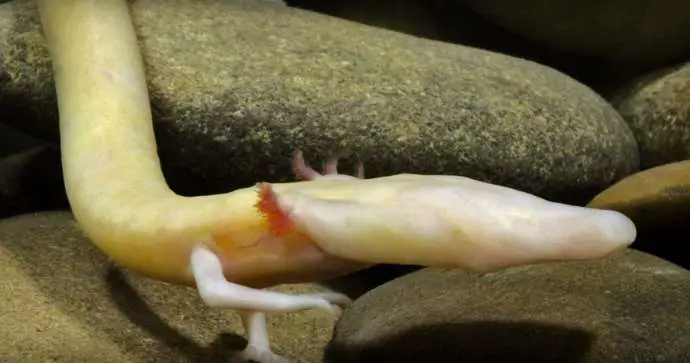The olm, proteus (Proteus anguinus), human fish or baby dragon. Call it what you will, but the small animal that takes pride of place in Postojna is easy to overlook if you know nothing about it. After all, it’s a small swimming blind lizard thing with a strange name that lives in a cave. So what?
Such an attitude would be a shame, indicating not only ignorance of some fascinating facts, as set out below, but also a missed opportunity to commune with the wonders of evolution and the remarkable results it can produce given time and enough selective pressure. Moreover, with Postojna Cave about to showcase another 21 of these animals now’s the perfect time to reawaken your sense of wonder for the human fish.
1. Although most closely associated with Postojna, the olm isn’t only found there. It also has natural homes in Italy, Croatia and Bosnia and Herzegovina, with some populations having being introduced elsewhere.
2. The olm is totally aquatic, eating, sleeping and breeding underwater in the total darkness of cave system. Wholly adapted to life in a cave, the olm is thus very sensitive that particular environment, and particularly vulnerable to pollution.
3. The name baby dragons isn’t part of some modern marketing plan, but part of the folklore related to this animal. It’s a term used by Johann Weikhard von Valvasor (1641 – 1693), the famed naturalist and historian. His Glory of the Duchy of Carniola, a foundational work of Slovenian culture, stated that after heavy rains the animals were washed up from underground waters, with locals believing they were the children of cave-dwelling dragons.
4. In On the Origin of Species Darwin presents to olm as an example of how evolution can lead to the loss of certain structures through lack of use:
Far from feeling surprise that some of the cave-animals should be very anomalous...as is the case with blind Proteus with reference to the reptiles of Europe, I am only surprised that more wrecks of ancient life have not been preserved, owing to the less severe competition to which the scanty inhabitants of these dark abodes will have been exposed.
However, the term “wreck of ancient life” shouldn't be taken literally, for far from being a wreck the olm is a remarkable testament to adaption.
5. One of the most noticeable adaptations is blindness. While the larvae have normal eyes they atrophy after four months, and thereafter remain as vestigial organs buried in the head. Olm can sense light, though, through their underdeveloped eyes and the skin itself.
6. The pink, translucent skin, resembling that of a white person in need of some sun, is due to a lack of pigmentation. However, if exposed to light the skin will begin to darken. There’s also a black olm, which lives closer to the surface and can be found near Črnomelj.
7. An olm swims with a serpentine twisting of its body, along with a few movements from its underdeveloped legs. These have three toes on the forelimbs, but only two on the hind ones
8. Another physical oddity of the olm is neoteny, retaining the characteristics of youth, like the axolotl. This is most clearly seen in the featherlike external gills, which a red fringe due to the oxygenated blood.
9. The long flat head carries a number of sense organs that help the olm survive underwater and in darkness, with the front part carrying chemo-, mechano-, and electroreceptors. There are also indications that olm use the Earth’s magnetic field for orientation.
It's in Slovene, but the video shows an olm regrowing a leg10. Olm live a long time, with one study estimating a maximum of more than 100 years, and putting the average lifespan of an adult at 68.5 years.
11. An adult female generally breeds once every 12.5 years, laying an average of 35 eggs. The embryos take between 86 and 140 days to develop, depending on the water temperature. It then takes 14 years for the little wonders to reach sexual maturity. Adults grow up to 30 cm long, with females bigger than males.
12. Olm have small teeth that act as a filter, rather than being used for chewing. All food, which includes small crustaceans, snails and insects are thus swallowed whole. If times are hard and there’s no food in the cave then an olm can do quite for a long time. In fact, what are termed “controlled experiments” found that the animals can live up to 10 years without a meal.
If you’d like to learn more about olm, and have the chance to see some baby dragons yourself, then consider a trip to Postojna Cave, with more details of that here.






